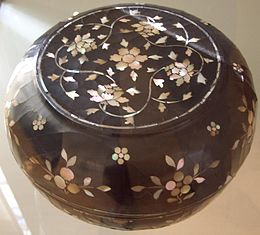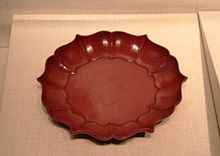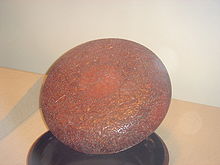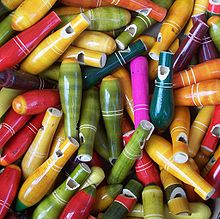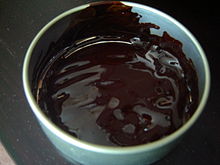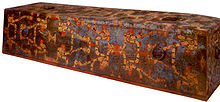- Lacquer
-
In a general sense, lacquer is a somewhat imprecise term for a clear or coloured varnish that dries by solvent evaporation and often a curing process as well that produces a hard, durable finish, in any sheen level from ultra matte to high gloss and that can be further polished as required. It is also used for "lacquer paint", which typically denotes a paint that dries to a more than usually hard and smooth surface.
The term lacquer originates from the Portuguese word for lac, a type of resin excreted from certain insects.[1] In terms of modern products, lac-based varnishes are referred to as shellac, while lacquer refers to other polymers dissolved in volatile organic compounds (VOCs), such as nitrocellulose, and later acrylic compounds dissolved in lacquer thinner, a mixture of several solvents typically containing butyl acetate and xylene or toluene. While both lacquer and shellac are traditional finishes, lacquer is more durable than shellac.
In terms of the decorative arts, lacquerware refers to variety of techniques used to decorate wood, metal or other surfaces, some involving carving into deep coatings of many layers of lacquer.
Contents
Etymology
The French word lacre "a kind of sealing wax", from Portuguese lacre, unexplained variant of lacca "resinous substance", from Arabic lakk, from Persian lak, the verb lac meaning "to cover or coat with laqueur".[2] The root of the word is the Sanskrit word laksha (लक्ष) meaning "one hundred thousand", which was used for both the Lac insect (because of their enormous number) and the scarlet resinous secretion it produces that was used as varnish in ancient India and neighbouring areas.[3][4] Lac resin was once imported in sizeable quantity into Europe from India along with Eastern woods.[5][6] The modern Hindi-Urdu word lakh (लाख, لاکھ), meaning "hundred thousand," is also derived from the same Sanskrit root-word.[3]
Urushiol-based lacquers
Urushiol-based lacquers differ from most others, being slow-drying, water-based, and set by oxidation and polymerization, rather than by evaporation alone. In order for it to set properly it requires humidity and warm temperature. The phenols oxidize and polymerize under the action of an enzyme laccase, yielding a substrate that, upon proper evaporation of its water content, is hard. Varnish resin is derived from a tree indigenous to China, species Toxicodendron vernicifluum, commonly known as the Lacquer Tree. Lacquer skills became very highly developed in Asia, and many highly decorated pieces were produced.
During the Shang Dynasty (ca. 1600–1046 BCE), the sophisticated techniques used in the lacquer process were first developed and it became a highly artistic craft,[7] although various prehistoric lacquerwares have been unearthed in China dating back to the Neolithic period and objects with lacquer coating in Japan from the late Jomon period.[7] The earliest extant lacquer object, a red wooden bowl,[8] was unearthed at a Hemudu culture (ca. 5000-4500 BCE) site in China.[9] By the Han Dynasty (206 BCE – 220 CE), many centres of lacquer production became firmly established.[7] The knowledge of the Chinese methods of the lacquer process spread from China during the Han, Tang and Song dynasties, eventually it was introduced to Korea, Japan, Southeast and South Asia.[10] The manufacturing process was introduced into Japan and remained secret for centuries.[11][clarification needed] These lacquers produce very hard, durable finishes that are both beautiful and very resistant to damage by water, acid, alkali or abrasion. The active ingredient of the resin is urushiol, a mixture of various phenols suspended in water, plus a few proteins.
The process of lacquer application in India is different from that which is followed in China and Japan.[citation needed] There are two types of lacquer: one obtained from the T. vernicifluum tree and the other from an insect. In India the insect lac was once used from which a red dye was first extracted, later what was left of the insect was a grease that was used for lacquering objects. The fresh resin from the T. vernicifluum trees causes urushiol-induced contact dermatitis and great care is required in its use. The Chinese treated the allergic reaction with shell-fish.
Trade of lacquer objects travelled through various routes to the Middle East. Known applications of lacquer in China included coffins, music instruments, furniture, and various household items.[7] Lacquer mixed with powdered cinnabar is used to produce the traditional red lacquerware from China.
The trees must be at least 10 years old before cutting to bleed the resin. It sets by a process called "aqua-polymerization", absorbing oxygen to set; placing in a humid environment allows it to absorb more oxygen from the evaporation of the water.
Lacquer-yielding trees in Thailand, Vietnam, Burma and Taiwan, called Thitsi, are slightly different; they do not contain urushiol, but similar substances called "laccol" or "thitsiol". The end result is similar but softer than the Chinese or Japanese lacquer. Unlike Japanese and Chinese Toxicodendron verniciflua resin, Burmese lacquer does not cause allergic reactions; it sets slower, and is painted by craftsmen's hands without using brushes.
Raw lacquer can be "coloured" by the addition of small amounts of iron oxides, giving red or black depending on the oxide. There is some evidence that its use is even older than 8,000 years from archaeological digs in China. Later, pigments were added to make colours. It is used not only as a finish, but mixed with ground fired and unfired clays applied to a mould with layers of hemp cloth, it can produce objects without need for another core like wood. The process is called "kanshitsu" in Japan. Advanced decorative techniques using additional materials such as gold and silver powders and flakes ("makie") were refined to very high standards in Japan also after having been introduced from China. In the lacquering of the Chinese musical instrument, the guqin, the lacquer is mixed with deer horn powder (or ceramic powder) to give it more strength so it can stand up to the fingering.
There are more than four forms of urushiol which is written as thus:
 R = (CH2)14CH3 or
R = (CH2)14CH3 or
R = (CH2)7CH=CH(CH2)5CH3 or
R = (CH2)7CH=CHCH2CH=CH(CH2)2CH3 or
R = (CH2)7CH=CHCH2CH=CHCH=CHCH3 or
R = (CH2)7CH=CHCH2CH=CHCH2CH=CH2 and others.Nitrocellulose lacquers
Quick-drying solvent-based lacquers that contain nitrocellulose, a resin obtained from the nitration of cotton and other cellulostic materials, were developed in the early 1920s, and extensively used in the automobile industry for 30 years. Prior to their introduction, mass produced automotive finishes were limited in colour, with Japan Black being the fastest drying and thus most popular. General Motors Oakland automobile brand automobile was the first (1923) to introduce one of the new fast drying nitrocelluous lacquers, a bright blue, produced by DuPont under their Duco tradename.
These lacquers are also used on wooden products, furniture primarily, and on musical instruments and other objects. The nitrocellulose and other resins and plasticizers are dissolved in the solvent, and each coat of lacquer dissolves some of the previous coat. These lacquers were a huge improvement over earlier automobile and furniture finishes, both in ease of application, and in colour retention. The preferred method of applying quick-drying lacquers is by spraying, and the development of nitrocellulose lacquers led to the first extensive use of spray guns. Nitrocellulose lacquers produce a very hard yet flexible, durable finish that can be polished to a high sheen. Drawbacks of these lacquers include the hazardous nature of the solvent, which is flammable, volatile and toxic; and the handling hazards of nitrocellulose in the lacquer manufacturing process. Lacquer grade of soluble nitrocellulose is closely related to the more highly nitrated form which is used to make explosives. They become relatively non-toxic after approximately a month since at this point, the lacquer has evaporated most of the solvents used in its production.
Acrylic lacquers
Lacquers using acrylic resin, a synthetic polymer, were developed in the 1950s. Acrylic resin is colourless, transparent thermoplastic, obtained by the polymerization of derivatives of acrylic acid. Acrylic is also used in enamel paints, which have the advantage of not needing to be buffed to obtain a shine. Enamels, however, are slow drying. The advantage of acrylic lacquer is its exceptionally fast drying time. The use of lacquers in automobile finishes was discontinued when tougher, more durable, weather- and chemical-resistant two-component polyurethane coatings were developed. The system usually consists of a primer, colour coat and clear topcoat, commonly known as clear coat finishes.
Water-based lacquers
Due to health risks and environmental considerations involved in the use of solvent-based lacquers, much work has gone in to the development of water-based lacquers. Such lacquers are considerably less toxic and more environmentally friendly, and in many cases, produce acceptable results. More and more water-based coloured lacquers are replacing solvent-based clear and coloured lacquers in underhood and interior applications in the automobile and other similar industrial applications. Water based lacquers are used extensively in wood furniture finishing as well.[citation needed]
Japanning
Just as china is a common name for porcelain, japanning is an old name to describe the European technique to imitate Asian lacquerware.[12] As Asian and Indian lacquer work became popular in England, France, the Netherlands, and Spain in the 17th century the Europeans developed imitations that were effectively a different technique of lacquering. The European technique, which is used on furniture and other objects, uses varnishes that have a resin base similar to shellac. The technique, which became known as japanning, involves applying several coats of varnish which are each heat-dried and polished. In the 18th century this type of lacquering gained a large popular following.
See also
References
- ^ lacquer. Dictionary.com. The American Heritage Dictionary of the English Language, Fourth Edition. Houghton Mifflin Company, 2004. http://dictionary.reference.com/browse/lacquer (accessed: May 05, 2008)
- ^ http://www.etymonline.com/index.php?term=lacquer
- ^ a b Franco Brunello (1973), The art of dyeing in the history of mankind, AATCC, 1973, http://books.google.com/books?id=MI-vbcXDdssC, "... The word lacquer derives, in fact, from the Sanskrit 'Laksha' and has the same meaning as the Hindi word 'Lakh' which signifies one-hundred thousand ... enormous number of those parasitical insects which infest the plants Acacia catecu, Ficus and Butea frondosa ... great quantity of reddish colored resinous substance ... used in ancient times in India and other parts of Asia ..."
- ^ Ulrich Meier-Westhues (2007-11), Polyurethanes: coatings, adhesives and sealants, Vincentz Network GmbH & Co KG, 2007, ISBN 9783878703341, http://books.google.com/books?id=wzOkvpgxLLQC, "... Shellac, a natural resin secreted by the scaly lac insect, has been used in India for centuries as a weather-resistant coating for surfaces. The word lacquer in English is derived from the Sanskrit word laksha. which means one hundred thousand ..."
- ^ Donald Frederick Lach, Edwin J. Van Kley (1994-02-04), Asia in the making of Europe, Volume 2, Book 1, University of Chicago Press, 1971, ISBN 9780226467306, http://books.google.com/books?id=BOitAB1Q0QcC, "... Along with valuable woods from the East, the ancients imported lac, a resinous incrustation produced on certain trees by the puncture of the lac insect. In India, lac was used as sealing wax, dye and varnish ... Sanskrit, laksha; Hindi, lakh; Persian, lak; Latin, lacca. The Western word "lacquer" is derived from this term ..."
- ^ Thomas Brock, Michael Groteklaes, Peter Mischke (2000), European coatings handbook, Vincentz Network GmbH & Co KG, 2000, ISBN 9783878705598, http://books.google.com/books?id=mAPG4Hdm5ycC, "... The word "lacquer" itself stems from the term "Laksha", from the pre-Christian, sacred Indian language Sanskrit, and originally referred to shellac, a resin produced by special insects ("lac insects") from the sap of an Indian fig tree ..."
- ^ a b c d Webb, Marianne (2000). Lacquer: Technology and conservation. Oxford: Butterworth-Heinemann. p. 3. ISBN 9780750644129.
- ^ Stark, Miriam T. (2005). Archaeology of Asia. Malden, MA : Blackwell Pub. Page 30. ISBN 1405102136.
- ^ Wang, Zhongshu. (1982). Han Civilization. Translated by K.C. Chang and Collaborators. New Haven and London: Yale University Press. Page 80. ISBN 0300027230.
- ^ Institute of the History of Natural Sciences and Chinese Academy of Sciences, ed (1983). Ancient China's technology and science. Beijing: Foreign Languages Press. p. 211. ISBN 9780835110013.
- ^ Britannica Online Encyclopedia: Oriental lacquer
- ^ Niimura, Noriyasu; Miyakoshi, Tetsuo (2003) Characterization of Natural Resin Films and Identification of Ancient Coating . J. Mass Spectrom. Soc. Jpn. 51, 440. JOI:JST.JSTAGE/massspec/51.439[dead link]
- Kimes, Beverly R., Editor. Clark, Henry A. (1996), The Standard Catalog of American Cars 1805–1945, Kraus Publications, ISBN 0-87341-428-4 p.1050
- Paolo Nanetti (2006), Coatings from A to Z, Vincentz Verlag, Hannover, ISBN 3-87870-173-X - A concise compilation of technical terms. Attached is a register of all German terms with their corresponding English terms and vice versa, in order to facilitate its use as a means for technical translation from one language to the other.
- Webb, Marianne (2000), Lacquer: Technology and Conservation, Butterworth Heinemann, ISBN 0-7506-4412-5 — A Comprehensive Guide to the Technology and Conservation of Asian and European Lacquer
- Michiko, Suganuma. "Japanese lacquer".[dead link]
Categories:- Decorative arts
- Chinese art
- Japanese art
- Coatings
- Resins
- Traditional Chinese objects
- Arabic words and phrases
Wikimedia Foundation. 2010.

